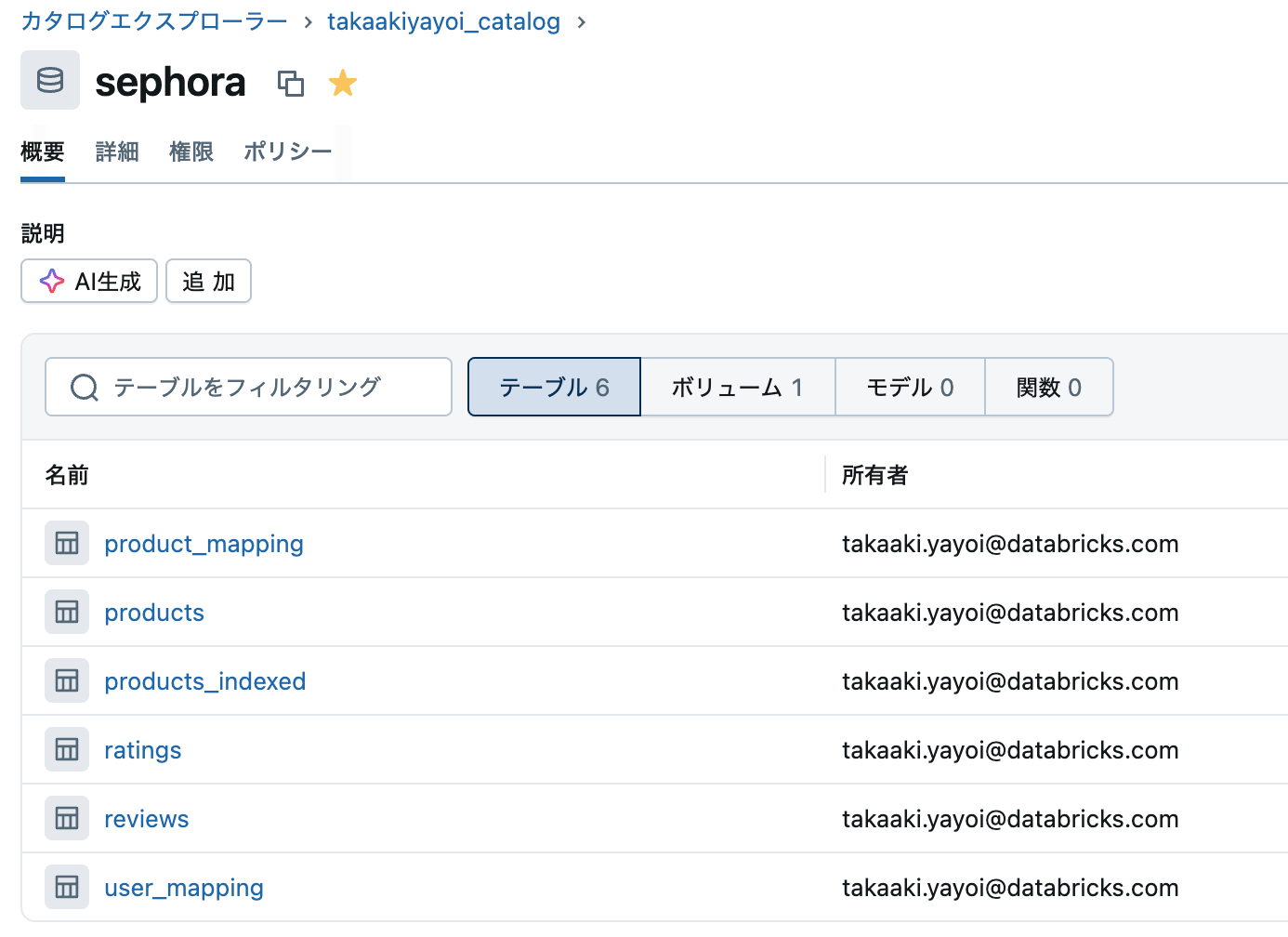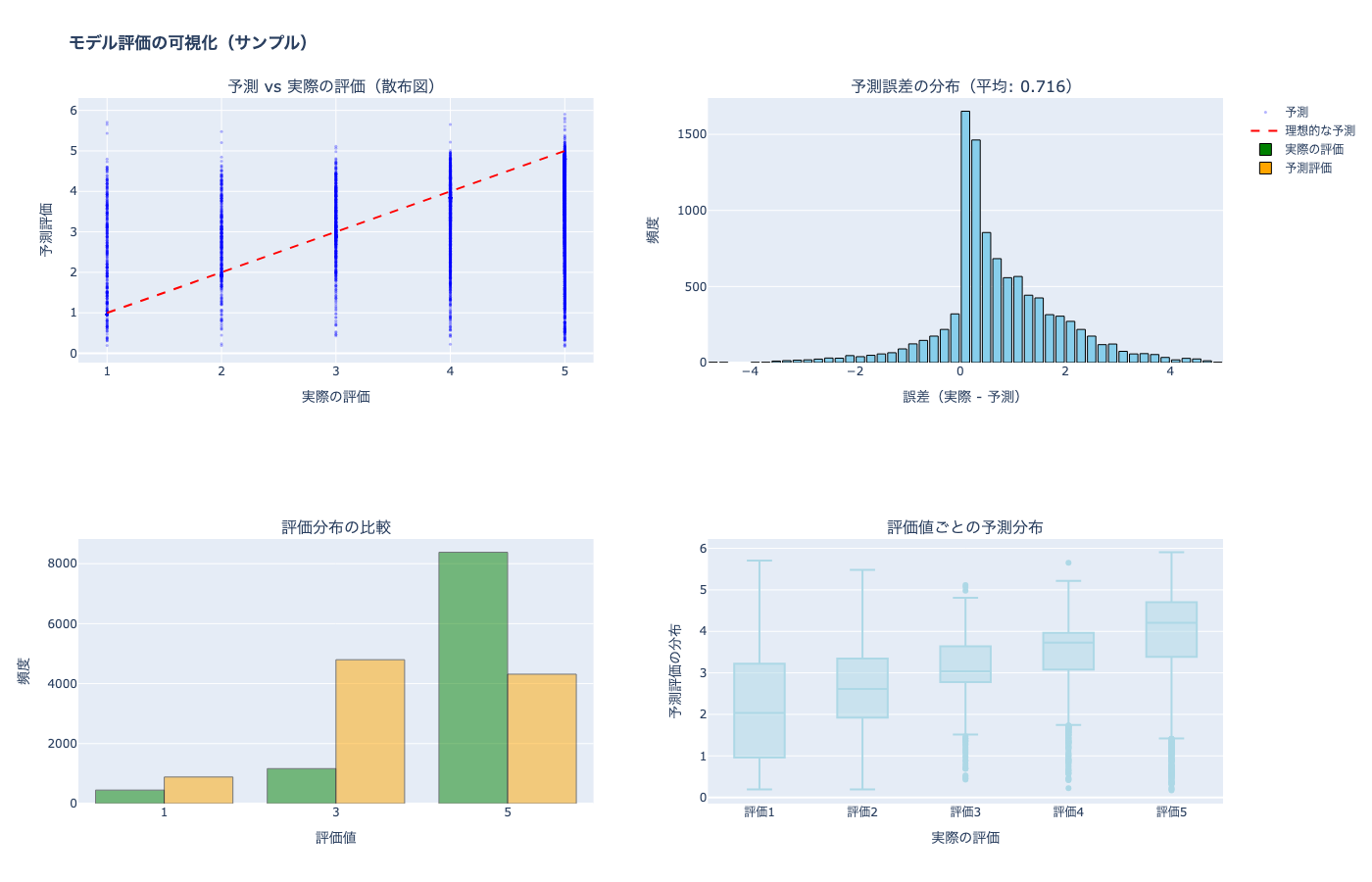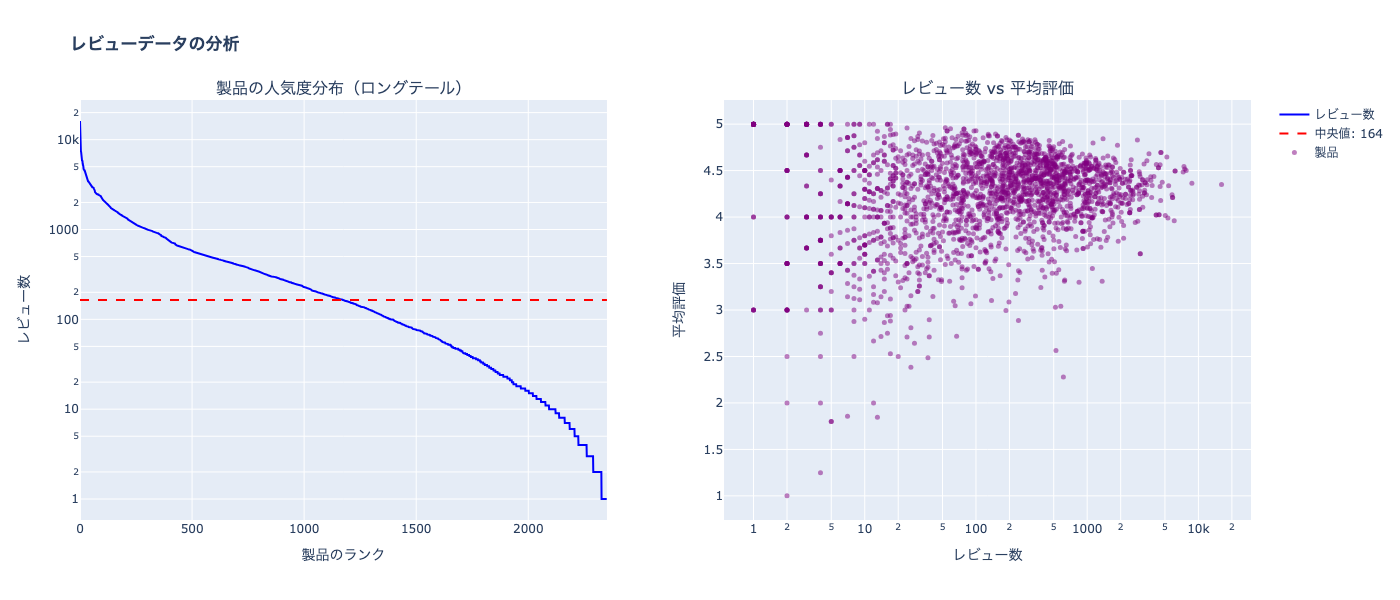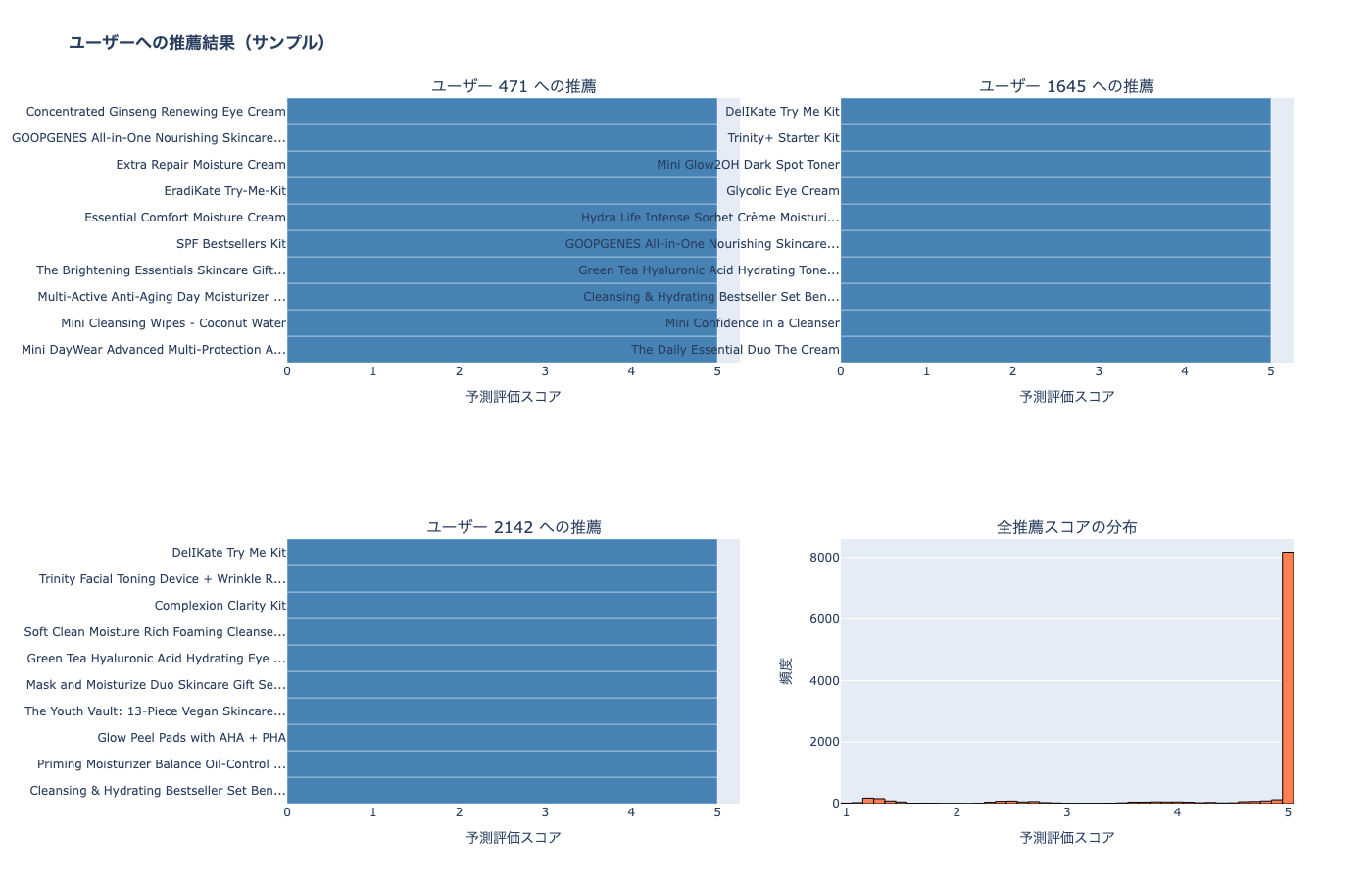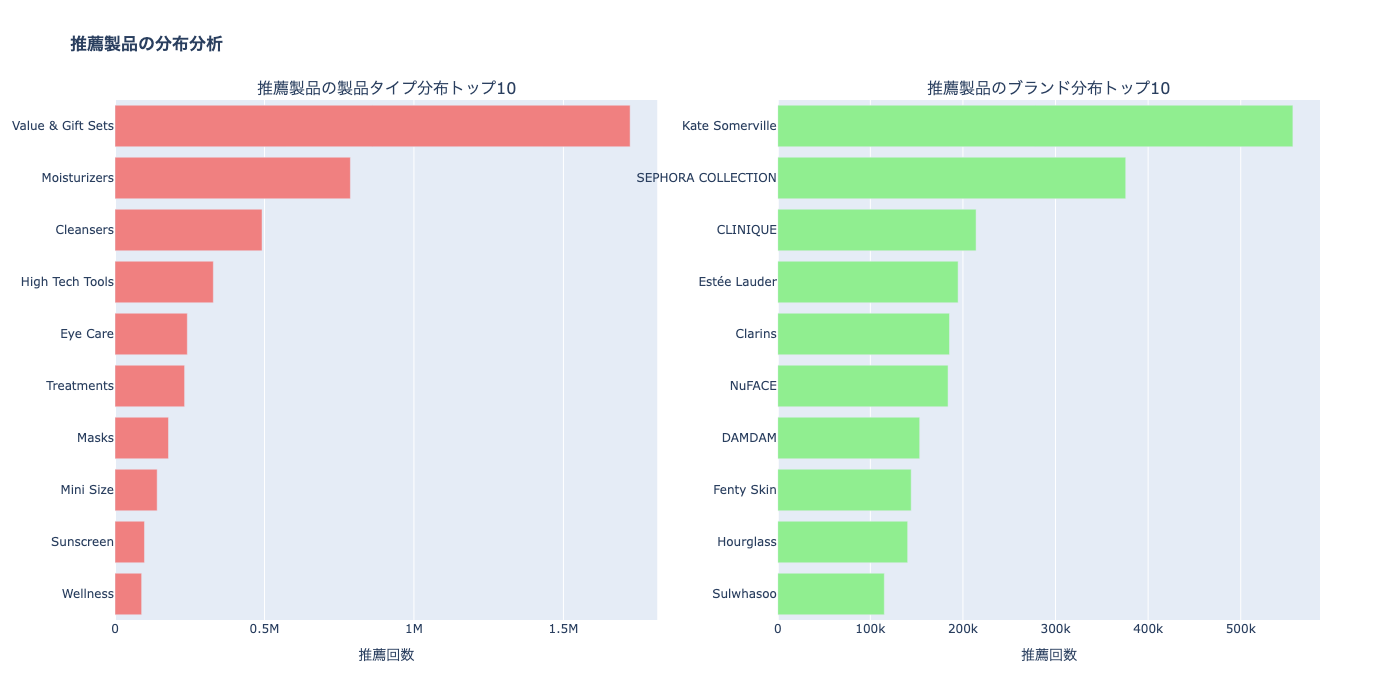協調フィルタリングくらいしか知りませんでしたが、他のレコメンダーモデルを勉強する機会があったので、その結果をノートブックにまとめました。
ちなみにマニュアルにも説明がありますが、こちらのTwo TowerモデルなどはGPUが必要で、私には難解でした。
こちらのソリューションアクセラレータはまだとっつきやすいです。今回は特にALSにフォーカスしています。
データセットはこちらの化粧品レビューデータを使っています。
準備としては、上のデータをダウンロードしてデータ準備ノートブックを実行、途中でデータをUnity Catalogのボリュームにアップロードします。ノートブックの実行が終わるとテーブルが作成されます。
以降が本論となります。
Sephora スキンケアレコメンダーシステム - ALSデモ
このノートブックでは、Apache Spark MLlibのALS (Alternating Least Squares) アルゴリズムを使用して、
スキンケア製品のレコメンダーシステムを構築します。
データセット: Sephora Products and Skincare Reviews
- 約110万件のレビュー
- 約8,500製品(スキンケア製品)
- ブランド、製品タイプ(モイスチャライザー、クレンザーなど)、価格情報
- ユーザー属性(肌タイプ、肌色など)
実行時間: 約20-30分
推奨クラスタースペック
このノートブックを効率的に実行するための推奨クラスター構成:
最小構成(開発・検証用)
- ランタイム: Databricks Runtime 14.3 LTS ML以降
- ドライバー: 8コア、32GB RAM (例: m5.2xlarge)
- ワーカー: 2ノード、各8コア、32GB RAM (例: m5.2xlarge)
- 総コア数: 24コア
推奨構成(本番・大規模データ用)
- ランタイム: Databricks Runtime 14.3 LTS ML以降
- ドライバー: 16コア、64GB RAM (例: m5.4xlarge)
- ワーカー: 4-8ノード、各16コア、64GB RAM (例: m5.4xlarge)
- 総コア数: 80-144コア
- オートスケーリング: 有効(4-8ノード)推奨
クラスター設定のポイント
- Spark構成: デフォルトのまま(自動チューニングが有効)
- 適応型クエリ実行(AQE): 有効(Databricks Runtime 10.4以降はデフォルト有効)
- スポットインスタンス: コスト削減のため、ワーカーに使用可能
Sparkの並列度が処理速度に効く箇所
このノートブックでは、以下の処理でSparkの並列度が処理時間に大きく影響します:
1. ALSモデルのトレーニング(最重要)⚡
model = als.fit(training)
- 影響度: 最大
- ALSは反復アルゴリズムで、ユーザー因子と製品因子を交互に更新
- 各イテレーションで大規模な行列演算が並列実行される
- データ量(110万レビュー)が多いため、並列度が処理時間に直結
-
推奨:
numUserBlocksとnumItemBlocksをクラスタのパーティション数に合わせて調整
2. 全ユーザーへの推薦生成
user_recs_raw = model.recommendForAllUsers(10)
- 影響度: 大
- 全ユーザー(数十万人)に対して並列で推薦を計算
- 各ユーザーごとに全製品とのスコア計算が必要
3. Window関数によるID変換
user_window = Window.orderBy("author_id")
user_indexer = reviews_clean.select("author_id").distinct()
.withColumn("userId", (row_number().over(user_window) - 1).cast("int"))
- 影響度: 中〜大
-
distinct()+row_number().over(Window)は全データのシャッフルが発生 - ソート処理が必要なため、パーティション数が影響
4. 集約処理(groupBy + agg)
review_stats = ratings.groupBy("productId").agg(
count("rating").alias("num_reviews"),
avg("rating").alias("avg_rating")
)
- 影響度: 中
-
groupBy().agg()はシャッフルを伴う並列集約 - パーティション間でデータを再分散
5. 類似製品の類似度計算
similar_products = item_factors
.withColumn("similarity", cosine_similarity_udf(col("features")))
- 影響度: 中
- UDFによる全製品の類似度計算が並列実行
並列度を調整する方法
必要に応じて、以下のような調整が可能です:
# 現在のパーティション数を確認
print(f"Training data partitions: {training.rdd.getNumPartitions()}")
# 再パーティション化(クラスタのコア数の2-3倍が目安)
training = training.repartition(200)
# ALS並列度の設定
als = ALS(
maxIter=10,
regParam=0.1,
rank=10,
numUserBlocks=50, # ユーザー行列のブロック数
numItemBlocks=50, # 製品行列のブロック数
...
)
協調フィルタリングとALS
ALSの仕組み
根本的なアプローチ:
メモリベースCF: 「似たユーザー/製品を見つける」→ 類似度を直接計算
ALS: 「ユーザーと製品の相性を予測する」→ 隠れた特徴を学習
具体例(スキンケア版):
従来のCF:
ユーザーA: モイスチャライザーA★5, クレンザーB★5, セラムC★2
ユーザーB: モイスチャライザーA★5, クレンザーB★4, セラムC★2
→ 「AとBは似ている」→ BがアイクリームDに★5 → Aにも推薦
ALS:
レビューデータから学習:
製品の特徴を発見 → モイスチャライザーA = [保湿力: 高, アンチエイジング: 中, 敏感肌向け: 低, ...]
ユーザーの嗜好 → ユーザーA = [保湿好き: 高, アンチエイジング好き: 中, 敏感肌: 低, ...]
推薦時:
アイクリームD = [保湿力: 高, アンチエイジング: 中, ...]
ユーザーAの嗜好との相性 = 内積計算 → 高スコア → 推薦!
この「隠れた特徴」を「潜在因子」と呼びます
ALSのメリット
- ✅ スケーラブル: 数百万ユーザー・製品に対応可能
- ✅ 高精度: 潜在因子による汎化性能
- ✅ スパース性に強い: 評価データが少なくても機能
- ✅ 並列化可能: Sparkで分散処理
Sparkを使うメリット
- 大規模データ処理: 110万レビューを効率的に処理
- 統合パイプライン: データ読み込みから推薦生成まで一貫
- 本番移行が容易: 開発コードをそのまま本番へ
- コスト効率: オートスケーリングとスポットインスタンス
内容
- データセットの準備(Unity Catalogテーブル)
- データの探索的分析(SQL・Python)
- データの分割(トレーニング/テスト)
- ALSモデルのトレーニング
- モデルの評価
- レコメンデーションの生成
- MLflow統合
- Unity Catalogモデル登録
- まとめ
1. データセットの準備
Unity Catalogテーブルから事前に準備されたデータを読み込みます。
前提条件: sephora_data_preparation.py ノートブックを先に実行してください。
from pyspark.sql import SparkSession
from pyspark.sql.types import StructType, StructField, IntegerType, StringType, DoubleType, LongType
from pyspark.sql.functions import col, count, avg, desc, row_number
from pyspark.sql.window import Window
# Unity Catalogの設定
CATALOG_NAME = "takaakiyayoi_catalog"
SCHEMA_NAME = "sephora"
print("Unity CatalogからSephoraデータセットを読み込み中...")
# Unity Catalogテーブルからデータを読み込み
products_indexed = spark.table(f"{CATALOG_NAME}.{SCHEMA_NAME}.products_indexed")
ratings = spark.table(f"{CATALOG_NAME}.{SCHEMA_NAME}.ratings")
reviews = spark.table(f"{CATALOG_NAME}.{SCHEMA_NAME}.reviews")
user_mapping = spark.table(f"{CATALOG_NAME}.{SCHEMA_NAME}.user_mapping")
product_mapping = spark.table(f"{CATALOG_NAME}.{SCHEMA_NAME}.product_mapping")
print("データ読み込み完了!")
print(f"製品データ件数: {products_indexed.count():,}")
print(f"評価データ件数: {ratings.count():,}")
print(f"レビューデータ件数: {reviews.count():,}")
print(f"ユニークユーザー数: {user_mapping.count():,}")
print(f"ユニーク製品数: {product_mapping.count():,}")
Unity CatalogからSephoraデータセットを読み込み中...
データ読み込み完了!
製品データ件数: 2,351
評価データ件数: 1,094,411
レビューデータ件数: 1,094,411
ユニークユーザー数: 503,216
ユニーク製品数: 2,351
# データの確認
print("=== 評価データサンプル ===")
display(ratings.limit(10))
| userId | productId | rating |
|---|---|---|
| 206037 | 759 | 4 |
| 476114 | 759 | 5 |
| 339578 | 2016 | 4 |
| 110146 | 2016 | 5 |
| 407579 | 1265 | 3 |
| 227950 | 1265 | 4 |
| 205688 | 1265 | 5 |
| 115344 | 1265 | 2 |
| 363426 | 1876 | 5 |
| 277621 | 2184 | 5 |
print("=== 製品データサンプル ===")
display(products_indexed.limit(10))
| productId | product_id_original | product_name | brand_name | price_usd | product_avg_rating | primary_category | secondary_category |
|---|---|---|---|---|---|---|---|
| 0 | P107306 | Renewing Eye Cream | Murad | 89 | 4.0316 | Skincare | Eye Care |
| 1 | P114902 | Goodbye Acne Max Complexion Correction Pads | Peter Thomas Roth | 48 | 4.4199 | Skincare | Treatments |
| 2 | P12045 | Grape Water Moisturizing Face Mist | Caudalie | 12 | 4.4431 | Skincare | Moisturizers |
| 3 | P122651 | Clarifying Lotion 1 | CLINIQUE | 20 | 4.515 | Skincare | Cleansers |
| 4 | P122661 | 7 Day Face Scrub Cream Rinse-Off Formula | CLINIQUE | 26 | 4.5321 | Skincare | Cleansers |
| 5 | P122718 | Exfoliating Face Scrub | CLINIQUE | 26 | 4.6122 | Skincare | Cleansers |
| 6 | P122727 | Repairwear Anti-Gravity Eye Cream | CLINIQUE | 54 | 4.1702 | Skincare | Eye Care |
| 7 | P122762 | Rinse-Off Foaming Cleanser | CLINIQUE | 23.5 | 4.4933 | Skincare | Cleansers |
| 8 | P122767 | All About Lips | CLINIQUE | 28 | 4.0178 | Skincare | Lip Balms & Treatments |
| 9 | P122774 | All About Eyes Eye Cream | CLINIQUE | 37 | 4.0722 | Skincare | Eye Care |
print("=== レビューデータサンプル ===")
display(reviews.limit(10))
| author_id | product_id | rating | is_recommended | review_text | review_title | skin_tone | eye_color | skin_type | hair_color |
|---|---|---|---|---|---|---|---|---|---|
| 2190293206 | P443842 | 2 | false | Used to swear by this product but hate the smell of the reformulation. Love the price, but willing to spend more for a product that doesn’t smell gross | null | lightMedium | brown | combination | brown |
| 9113341005 | P443842 | 5 | true | I’ve only been using this for a week and my skin is so much softer. It’s not as “harsh” on my skin as The Ordinary’s retinol- it took some getting used to but not this one. I’m not purging and my skin isn’t drying | More tolerable than The Ordinary | deep | brown | normal | black |
| 23866342710 | P443842 | 1 | false | Why, why, why would you change the formula?!!! I have been using this for year. It was truly amazing. Constantly getting compliments on my skin. I am 40 years old and it was perfect. I opened my new bottle and thought I got a bad one. It was rancid. Ordered a second bottle and the same. I am so upset. Why would they change it. | New formula is awful very sad | fairLight | blue | combination | blonde |
| 1328806527 | P443842 | 1 | false | I have used this product for years and it has been nothing short of awesome. Honestly, I am 44 and people think I am in my early 30s because of what this does for my skin. Hardly a wrinkle in sight. However, the latest package I bought in Feb 2023 contained serum that smelled rancid. Like spoiled milk. I tried it anyway and it felt thick and awful on my skin. I returned it to Sephora and learned that Inkey List REFORMULATED this product. I am SO upset. I really hope Inkey goes back to the old formulation because the new one is garbage. | Recently reformulated and the new formula is AWFUL | light | brown | combination | gray |
| 31262847082 | P443842 | 5 | true | Great product for anti-aging Also great for dark spots | Must have product in my nighttime skincare routine | lightMedium | hazel | combination | brown |
| 38092205147 | P443842 | 4 | true | I’ve been using this product twice a week and I’ve seen results. My skin is smothered, my pores look better and it feels healthy. You get what you pay for! | null | null | null | null | null |
| 5090375964 | P443842 | 4 | true | Decent serum ; it didn’t cause any breakouts while using at nighttime.Just a bit heavy on my complexion. | Great size | null | brown | combination | black |
| 42425576020 | P443842 | 5 | true | I recently bought this about less than 4 days ago, I’m not sure if there was a bad batch or what but mine does not smell of whatever everyone else is talking about. There is no smell to mine? | No smell for me! | fairLight | gray | combination | blonde |
| 6768361454 | P443842 | 1 | false | Been using this product for well over a year and loved it. Recently restocked and thought I bought the wrong thing because it smells HORRIBLE, I can’t push through it. Idk why they would change the formula but sad I have to find a new one | null | light | hazel | combination | brown |
| 6860968769 | P443842 | 1 | false | I used to swear by this product, but after the last purchase I made I will not be restocking this ever again. I literally thought I received something rotting inside as soon as I opened it. Shocked, I returned to the store get a new one only to open it in-store and discover the new formulation just smells like this. I literally threw up in my mouth. Save yourselves. new | Threw up in my mouth - new formulation SUCKS | lightMedium | blue | dry | brown |
2. データの探索的分析
2.1 SQLを使用した基本統計
%sql
-- 基本統計情報
SELECT
'評価データ' as metric_name,
COUNT(*) as total_ratings,
COUNT(DISTINCT userId) as unique_users,
COUNT(DISTINCT productId) as unique_products,
ROUND(AVG(rating), 2) as avg_rating,
MIN(rating) as min_rating,
MAX(rating) as max_rating
FROM takaakiyayoi_catalog.sephora.ratings
| metric_name | total_ratings | unique_users | unique_products | avg_rating | min_rating | max_rating |
|---|---|---|---|---|---|---|
| 評価データ | 1094411 | 503216 | 2351 | 4.3 | 1 | 5 |
%sql
-- 評価値の分布
SELECT
rating,
COUNT(*) as count,
ROUND(COUNT(*) * 100.0 / SUM(COUNT(*)) OVER (), 2) as percentage
FROM takaakiyayoi_catalog.sephora.ratings
GROUP BY rating
ORDER BY rating DESC
| rating | count | percentage |
|---|---|---|
| 5 | 698951 | 63.87 |
| 4 | 199389 | 18.22 |
| 3 | 81816 | 7.48 |
| 2 | 53032 | 4.85 |
| 1 | 61223 | 5.59 |
2.2 最もレビューされた製品
%sql
-- 最もレビューされた製品トップ10
SELECT
p.product_name,
p.brand_name,
COUNT(*) as num_reviews,
ROUND(AVG(r.rating), 2) as avg_rating,
p.price_usd,
p.primary_category
FROM takaakiyayoi_catalog.sephora.ratings r
JOIN takaakiyayoi_catalog.sephora.products_indexed p
ON r.productId = p.productId
GROUP BY p.productId, p.product_name, p.brand_name, p.price_usd, p.primary_category
ORDER BY num_reviews DESC
LIMIT 10
| product_name | brand_name | num_reviews | avg_rating | price_usd | primary_category |
|---|---|---|---|---|---|
| Lip Sleeping Mask Intense Hydration with Vitamin C | LANEIGE | 16138 | 4.35 | 24 | Skincare |
| Soy Hydrating Gentle Face Cleanser | fresh | 8736 | 4.36 | 39 | Skincare |
| 100 percent Pure Argan Oil | Josie Maran | 7763 | 4.5 | 49 | Skincare |
| Ultra Repair Cream Intense Hydration | First Aid Beauty | 7547 | 4.52 | 38 | Skincare |
| Alpha Beta Extra Strength Daily Peel Pads | Dr. Dennis Gross Skincare | 7414 | 4.55 | 92 | Skincare |
| The True Cream Aqua Bomb | belif | 7294 | 4.48 | 38 | Skincare |
| Green Clean Makeup Removing Cleansing Balm | Farmacy | 6169 | 4.5 | 36 | Skincare |
| Green Clean Makeup Meltaway Cleansing Balm Limited Edition Jumbo | Farmacy | 6169 | 4.5 | 60 | Skincare |
| Protini Polypeptide Firming Refillable Moisturizer | Drunk Elephant | 6063 | 3.96 | 68 | Skincare |
| Superfood Antioxidant Cleanser | Youth To The People | 5864 | 4.21 | 39 | Skincare |
2.3 カテゴリ別分析(製品タイプ別)
このデータセットはスキンケア製品に特化しており、secondary_categoryに詳細な製品タイプ(モイスチャライザー、クレンザー、セラムなど)が含まれています。
%sql
-- 製品タイプ別の統計(secondary_category)
SELECT
p.secondary_category as product_type,
COUNT(DISTINCT p.productId) as product_count,
COUNT(r.rating) as total_reviews,
ROUND(AVG(r.rating), 2) as avg_rating,
ROUND(AVG(p.price_usd), 2) as avg_price
FROM takaakiyayoi_catalog.sephora.products_indexed p
LEFT JOIN takaakiyayoi_catalog.sephora.ratings r
ON p.productId = r.productId
WHERE p.secondary_category IS NOT NULL
AND p.secondary_category != ''
GROUP BY p.secondary_category
ORDER BY product_count DESC
LIMIT 15
| product_type | product_count | total_reviews | avg_rating | avg_price |
|---|---|---|---|---|
| Moisturizers | 538 | 297399 | 4.32 | 61.74 |
| Treatments | 452 | 222042 | 4.3 | 60.65 |
| Cleansers | 354 | 200604 | 4.34 | 36.24 |
| Eye Care | 184 | 74999 | 4.18 | 55.42 |
| Value & Gift Sets | 170 | 12099 | 4.27 | 68.72 |
| Masks | 165 | 70531 | 4.34 | 44.31 |
| Mini Size | 110 | 85498 | 4.29 | 23.32 |
| Sunscreen | 108 | 41139 | 4.17 | 39.31 |
| Wellness | 79 | 10530 | 4.17 | 40.21 |
| High Tech Tools | 76 | 5925 | 4.18 | 130.14 |
| Lip Balms & Treatments | 61 | 61688 | 4.33 | 19.26 |
| Self Tanners | 53 | 11942 | 4.08 | 35.83 |
| Shop by Concern | 1 | 15 | 4.27 | 28 |
2.4 ブランド別分析
%sql
-- 人気ブランドトップ15(レビュー数順)
SELECT
p.brand_name,
COUNT(DISTINCT p.productId) as product_count,
COUNT(r.rating) as total_reviews,
ROUND(AVG(r.rating), 2) as avg_rating,
ROUND(AVG(p.price_usd), 2) as avg_price
FROM takaakiyayoi_catalog.sephora.products_indexed p
JOIN takaakiyayoi_catalog.sephora.ratings r
ON p.productId = r.productId
WHERE p.brand_name IS NOT NULL
GROUP BY p.brand_name
ORDER BY total_reviews DESC
LIMIT 15
| brand_name | product_count | total_reviews | avg_rating | avg_price |
|---|---|---|---|---|
| CLINIQUE | 88 | 49029 | 4.25 | 36.39 |
| Tatcha | 40 | 46770 | 4.24 | 53.16 |
| Drunk Elephant | 38 | 42395 | 4.09 | 54.97 |
| fresh | 48 | 40886 | 4.38 | 46.96 |
| The Ordinary | 45 | 35934 | 4.21 | 11.05 |
| Glow Recipe | 27 | 31490 | 4.32 | 33.56 |
| Youth To The People | 27 | 29154 | 4.28 | 36.3 |
| Origins | 38 | 29063 | 4.36 | 32.44 |
| Peter Thomas Roth | 56 | 28846 | 4.32 | 51.96 |
| LANEIGE | 26 | 27519 | 4.37 | 25.88 |
| Farmacy | 23 | 26536 | 4.44 | 44.39 |
| The INKEY List | 41 | 25706 | 4 | 11.47 |
| Sunday Riley | 25 | 25388 | 4.22 | 80.83 |
| OLEHENRIKSEN | 31 | 25072 | 4.37 | 45.55 |
| Dermalogica | 48 | 24415 | 4.61 | 52.47 |
2.5 価格帯別分析
%sql
-- 価格帯別の製品数とレビュー統計
SELECT
CASE
WHEN price_usd < 20 THEN '0-19ドル'
WHEN price_usd < 40 THEN '20-39ドル'
WHEN price_usd < 60 THEN '40-59ドル'
WHEN price_usd < 80 THEN '60-79ドル'
WHEN price_usd < 100 THEN '80-99ドル'
ELSE '100ドル以上'
END as price_range,
COUNT(DISTINCT p.productId) as product_count,
COUNT(r.rating) as total_reviews,
ROUND(AVG(r.rating), 2) as avg_rating
FROM takaakiyayoi_catalog.sephora.products_indexed p
LEFT JOIN takaakiyayoi_catalog.sephora.ratings r
ON p.productId = r.productId
WHERE p.price_usd IS NOT NULL
GROUP BY
CASE
WHEN price_usd < 20 THEN '0-19ドル'
WHEN price_usd < 40 THEN '20-39ドル'
WHEN price_usd < 60 THEN '40-59ドル'
WHEN price_usd < 80 THEN '60-79ドル'
WHEN price_usd < 100 THEN '80-99ドル'
ELSE '100ドル以上'
END
ORDER BY
CASE price_range
WHEN '0-19ドル' THEN 1
WHEN '20-39ドル' THEN 2
WHEN '40-59ドル' THEN 3
WHEN '60-79ドル' THEN 4
WHEN '80-99ドル' THEN 5
ELSE 6
END
| price_range | product_count | total_reviews | avg_rating |
|---|---|---|---|
| 0-19ドル | 341 | 184417 | 4.26 |
| 20-39ドル | 731 | 372559 | 4.28 |
| 40-59ドル | 494 | 231895 | 4.32 |
| 60-79ドル | 359 | 161393 | 4.33 |
| 80-99ドル | 177 | 79193 | 4.35 |
| 100ドル以上 | 249 | 64954 | 4.27 |
2.6 高評価製品の分析
%sql
-- 高評価製品トップ10(レビュー数10件以上)
SELECT
p.product_name,
p.brand_name,
COUNT(*) as num_reviews,
ROUND(AVG(r.rating), 2) as avg_rating,
p.price_usd,
p.primary_category
FROM takaakiyayoi_catalog.sephora.ratings r
JOIN takaakiyayoi_catalog.sephora.products_indexed p
ON r.productId = p.productId
GROUP BY p.productId, p.product_name, p.brand_name, p.price_usd, p.primary_category
HAVING COUNT(*) >= 10
ORDER BY avg_rating DESC, num_reviews DESC
LIMIT 10
| product_name | brand_name | num_reviews | avg_rating | price_usd | primary_category |
|---|---|---|---|---|---|
| Skin Filter Daily Brightening Phyto-Retinol + AHA Serum | The Nue Co. | 17 | 5 | 65 | Skincare |
| LUNA 4 Facial Cleansing & Firming Massage for Balanced Skin | FOREO | 16 | 5 | 279 | Skincare |
| Liquid Gold Midnight Reboot Serum with 14% Glycolic Acid and Tripeptide-5 | Alpha-H | 16 | 5 | 105 | Skincare |
| Barrier Culture Moisturizer with Niacinamide & Squalane | The Nue Co. | 12 | 5 | 65 | Skincare |
| Barrier Culture Cleanser Pre-, Pro- & Postbiotic Face Wash | The Nue Co. | 11 | 5 | 42 | Skincare |
| Youth Reformer Firming Vitamin C Oil Serum | FaceGym | 53 | 4.96 | 110 | Skincare |
| Multi Action Clear Acne Control 30-Day Trial Kit | StriVectin | 24 | 4.96 | 39 | Skincare |
| Mini Evening Primrose + Green Tea Algae Retinol Face Oil | MARA | 78 | 4.95 | 66 | Skincare |
| Evening Primrose + Green Tea Algae Retinol Face Oil | MARA | 78 | 4.95 | 120 | Skincare |
| Tan Build Up Remover Mitt | St. Tropez | 59 | 4.95 | 9 | Skincare |
3. データの分割
トレーニングデータとテストデータに分割します(80:20)
# データをトレーニングとテストに分割
(training, test) = ratings.randomSplit([0.8, 0.2], seed=42)
print(f"トレーニングデータ: {training.count():,} 件")
print(f"テストデータ: {test.count():,} 件")
トレーニングデータ: 876,200 件
テストデータ: 218,211 件
4. ALSモデルのトレーニング
製品レコメンデーションのためにALSモデルをトレーニングします。
パラメータ:
-
maxIter: イテレーション数 -
regParam: 正則化パラメータ(過学習を防ぐ) -
rank: 潜在因子の数 -
coldStartStrategy: 新規ユーザー/製品の扱い
from pyspark.ml.recommendation import ALS
from pyspark.ml.evaluation import RegressionEvaluator
import mlflow
import mlflow.spark
# MLflow実験の設定
mlflow.set_experiment("/Users/takaaki.yayoi@databricks.com/20251104_sephora_als/sephora_recommender_experiment")
print("ALSモデルのトレーニング開始...")
# MLflowで実験を記録
with mlflow.start_run(run_name="sephora_als_baseline") as run:
# パラメータの設定
max_iter = 10
reg_param = 0.1
rank = 10
# データセットのリネージを記録
training_dataset = mlflow.data.from_spark(
training,
table_name=f"{CATALOG_NAME}.{SCHEMA_NAME}.ratings",
version="0"
)
mlflow.log_input(training_dataset, context="training")
test_dataset = mlflow.data.from_spark(
test,
table_name=f"{CATALOG_NAME}.{SCHEMA_NAME}.ratings",
version="0"
)
mlflow.log_input(test_dataset, context="validation")
# ALSモデルの構築
als = ALS(
maxIter=max_iter,
regParam=reg_param,
rank=rank,
userCol="userId",
itemCol="productId",
ratingCol="rating",
coldStartStrategy="drop",
nonnegative=True
)
# パラメータをMLflowにロギング
mlflow.log_param("maxIter", max_iter)
mlflow.log_param("regParam", reg_param)
mlflow.log_param("rank", rank)
mlflow.log_param("coldStartStrategy", "drop")
mlflow.log_param("nonnegative", True)
# データセット情報をロギング
mlflow.log_param("training_count", training.count())
mlflow.log_param("test_count", test.count())
# モデルのトレーニング
model = als.fit(training)
print("トレーニング完了!")
print(f"MLflow Run ID: {run.info.run_id}")
# 評価指標の計算用evaluatorを準備
evaluator = RegressionEvaluator(
metricName="rmse",
labelCol="rating",
predictionCol="prediction"
)
# テストデータで予測
predictions = model.transform(test)
# RMSEを計算
rmse = evaluator.evaluate(predictions)
# メトリクスをMLflowにロギング
mlflow.log_metric("rmse", rmse)
mlflow.log_metric("test_rmse", rmse)
# 追加のメトリクス(MAE)も計算してロギング
evaluator_mae = RegressionEvaluator(
metricName="mae",
labelCol="rating",
predictionCol="prediction"
)
mae = evaluator_mae.evaluate(predictions)
mlflow.log_metric("mae", mae)
# モデルのsignatureを作成(Unity Catalog登録用)
from mlflow.models import infer_signature
# サンプル入力データ(userId, productId)
sample_input = test.select("userId", "productId").limit(10).toPandas()
# サンプル出力データ(予測結果)
sample_output = predictions.select("userId", "productId", "prediction").limit(10).toPandas()
# signatureを推論
signature = infer_signature(sample_input, sample_output)
# モデルをMLflowに保存(signatureを含める)
mlflow.spark.log_model(
model,
"als-model",
signature=signature,
registered_model_name=None
)
print(f"テストデータのRMSE = {rmse:.3f}")
print(f"テストデータのMAE = {mae:.3f}")
print(f"✓ モデルをsignature付きで保存しました")
テストデータのRMSE = 1.323
テストデータのMAE = 0.968
✓ モデルをsignature付きで保存しました
MLflowのエクスペリメントからモデルに関する情報を確認できます。
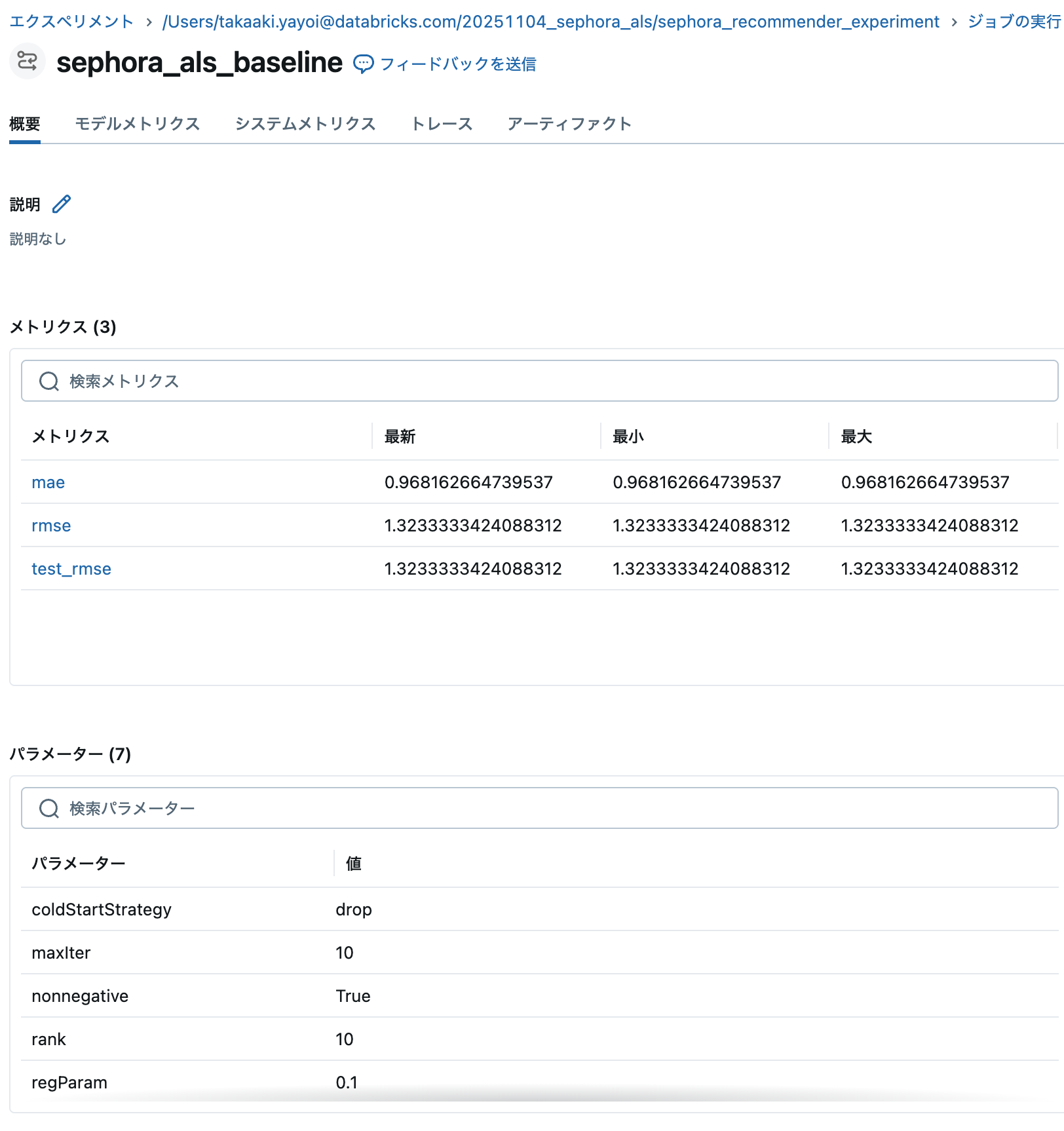
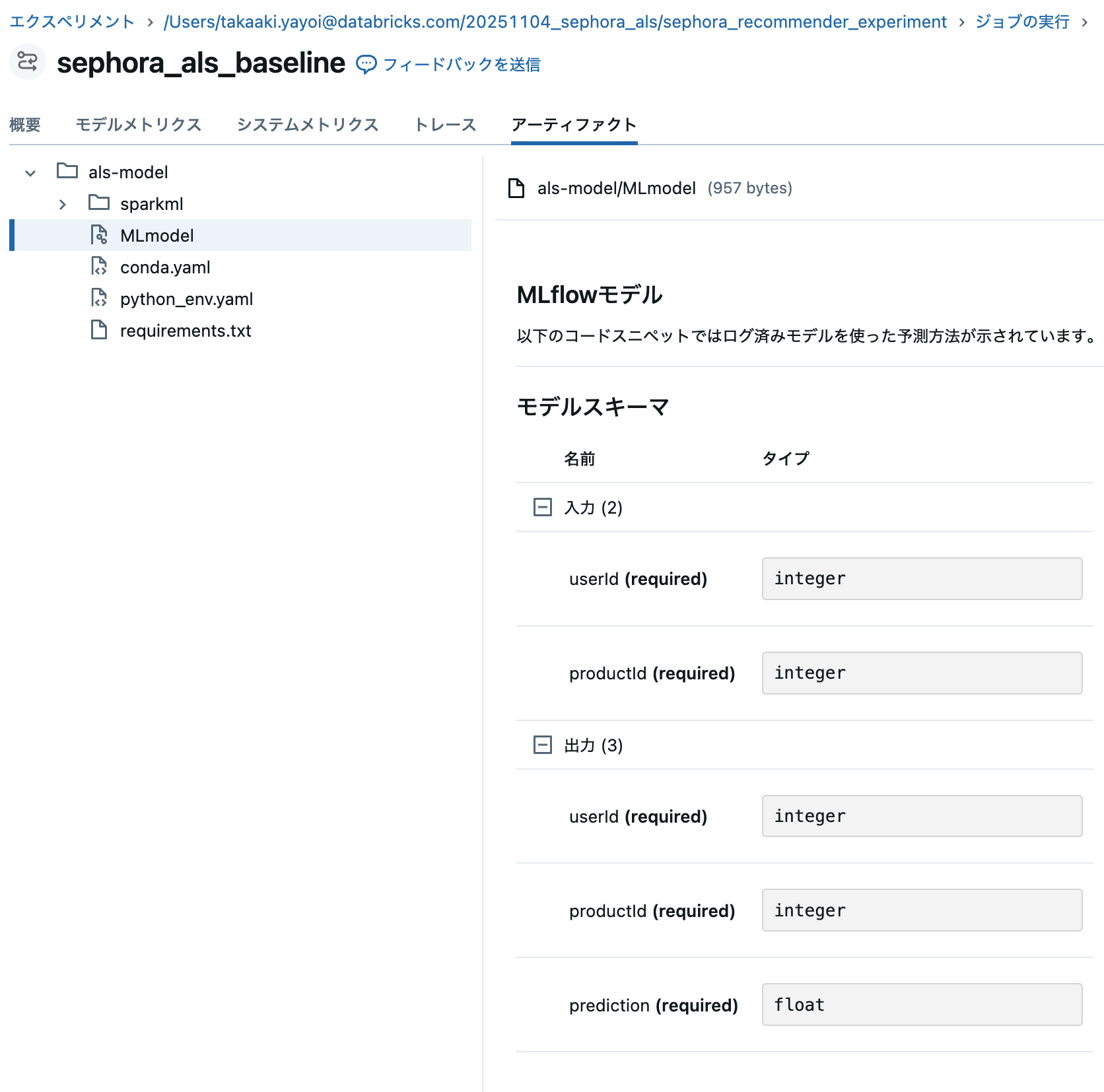
5. モデルの評価
RMSE (Root Mean Squared Error) を使用してモデルの性能を評価します。
# 予測結果の確認
print("=== 予測結果サンプル ===")
display(
predictions
.join(products_indexed, "productId")
.select("userId", "product_name", "brand_name", "rating", "prediction")
.limit(10)
)
=== 予測結果サンプル ===
| userId | product_name | brand_name | rating | prediction |
|---|---|---|---|---|
| 31 | Take The Day Off Cleansing Balm Makeup Remover | CLINIQUE | 5 | 4.812748432159424 |
| 53 | Niacinamide 10% + Zinc 1% Oil Control Serum | The Ordinary | 5 | 2.2006661891937256 |
| 78 | Midnight Recovery Concentrate Moisturizing Face Oil | Kiehl's Since 1851 | 2 | 2.1206536293029785 |
| 85 | Lala Retro Whipped Refillable Moisturizer with Ceramides | Drunk Elephant | 5 | 3.8595359325408936 |
| 108 | Vinosource-Hydra Moisturizing Sorbet | Caudalie | 5 | 3.5733797550201416 |
| 321 | Santorini Grape Poreless Skin Cream | KORRES | 5 | 3.796710968017578 |
| 322 | Balancing Force Oil Control Toner | OLEHENRIKSEN | 5 | 2.9253413677215576 |
| 471 | Mini Superfood Antioxidant Cleanser | Youth To The People | 5 | 4.6766791343688965 |
| 580 | Even Smoother Glycolic Retinol Resurfacing Serum | Peter Thomas Roth | 5 | 4.7179436683654785 |
| 580 | Cold Plunge Pore Remedy Moisturizer with BHA/LHA | OLEHENRIKSEN | 5 | 3.7894437313079834 |
5.1 モデル結果の可視化
import plotly.graph_objects as go
import plotly.express as px
from plotly.subplots import make_subplots
import numpy as np
# Pandasに変換して可視化(サンプリングして軽量化)
predictions_pd = predictions.select("rating", "prediction").sample(fraction=0.1, seed=42).limit(10000).toPandas()
errors = predictions_pd['rating'] - predictions_pd['prediction']
# サブプロット作成
fig = make_subplots(
rows=2, cols=2,
subplot_titles=(
'予測 vs 実際の評価(散布図)',
f'予測誤差の分布(平均: {errors.mean():.3f})',
'評価分布の比較',
'評価値ごとの予測分布'
),
specs=[[{"type": "scatter"}, {"type": "histogram"}],
[{"type": "histogram"}, {"type": "box"}]]
)
# 1. 予測 vs 実際の評価 - 散布図
fig.add_trace(
go.Scatter(
x=predictions_pd['rating'],
y=predictions_pd['prediction'],
mode='markers',
marker=dict(size=3, opacity=0.3, color='blue'),
name='予測',
showlegend=True
),
row=1, col=1
)
# 理想的な予測線
fig.add_trace(
go.Scatter(
x=[1, 5], y=[1, 5],
mode='lines',
line=dict(color='red', dash='dash', width=2),
name='理想的な予測',
showlegend=True
),
row=1, col=1
)
# 2. 予測誤差のヒストグラム
fig.add_trace(
go.Histogram(
x=errors,
nbinsx=50,
marker=dict(color='skyblue', line=dict(color='black', width=1)),
name='誤差分布',
showlegend=False
),
row=1, col=2
)
# 3. 実際の評価の分布 vs 予測の評価の分布
fig.add_trace(
go.Histogram(
x=predictions_pd['rating'],
nbinsx=5,
marker=dict(color='green', opacity=0.5, line=dict(color='black', width=1)),
name='実際の評価'
),
row=2, col=1
)
fig.add_trace(
go.Histogram(
x=predictions_pd['prediction'],
nbinsx=20,
marker=dict(color='orange', opacity=0.5, line=dict(color='black', width=1)),
name='予測評価'
),
row=2, col=1
)
# 4. 評価値ごとの予測分布(ボックスプロット)
for rating in sorted(predictions_pd['rating'].unique()):
fig.add_trace(
go.Box(
y=predictions_pd[predictions_pd['rating'] == rating]['prediction'],
name=f'評価{int(rating)}',
marker=dict(color='lightblue'),
showlegend=False
),
row=2, col=2
)
# レイアウト設定
fig.update_xaxes(title_text="実際の評価", row=1, col=1)
fig.update_yaxes(title_text="予測評価", row=1, col=1)
fig.update_xaxes(title_text="誤差(実際 - 予測)", row=1, col=2)
fig.update_yaxes(title_text="頻度", row=1, col=2)
fig.update_xaxes(title_text="評価値", row=2, col=1)
fig.update_yaxes(title_text="頻度", row=2, col=1)
fig.update_xaxes(title_text="実際の評価", row=2, col=2)
fig.update_yaxes(title_text="予測評価の分布", row=2, col=2)
fig.update_layout(
height=900,
width=1400,
title_text="<b>モデル評価の可視化(サンプル)</b>",
showlegend=True,
font=dict(size=12)
)
fig.show(config={'displayModeBar': True})
print(f"\n=== 予測精度の統計 ===")
print(f"誤差の平均: {errors.mean():.3f}")
print(f"誤差の標準偏差: {errors.std():.3f}")
print(f"平均絶対誤差 (MAE): {abs(errors).mean():.3f}")
=== 予測精度の統計 ===
誤差の平均: 0.716
誤差の標準偏差: 1.136
平均絶対誤差 (MAE): 0.980
5.2 データ分析の可視化
# レビュー数の分析
product_stats = ratings.groupBy("productId").agg(
count("rating").alias("num_reviews"),
avg("rating").alias("avg_rating")
).toPandas()
# サブプロット作成
fig = make_subplots(
rows=1, cols=2,
subplot_titles=(
'製品の人気度分布(ロングテール)',
'レビュー数 vs 平均評価'
)
)
# 1. 製品ごとのレビュー数分布
sorted_counts = product_stats['num_reviews'].sort_values(ascending=False).values
fig.add_trace(
go.Scatter(
x=list(range(len(sorted_counts))),
y=sorted_counts,
mode='lines',
line=dict(color='blue', width=2),
name='レビュー数',
showlegend=True
),
row=1, col=1
)
# 中央値の線
median_val = product_stats['num_reviews'].median()
fig.add_trace(
go.Scatter(
x=[0, len(sorted_counts)],
y=[median_val, median_val],
mode='lines',
line=dict(color='red', dash='dash', width=2),
name=f'中央値: {median_val:.0f}',
showlegend=True
),
row=1, col=1
)
# 2. 平均評価とレビュー数の関係
fig.add_trace(
go.Scatter(
x=product_stats['num_reviews'],
y=product_stats['avg_rating'],
mode='markers',
marker=dict(size=5, opacity=0.5, color='purple'),
name='製品',
showlegend=True
),
row=1, col=2
)
# レイアウト設定
fig.update_xaxes(title_text="製品のランク", row=1, col=1)
fig.update_yaxes(title_text="レビュー数", type="log", row=1, col=1)
fig.update_xaxes(title_text="レビュー数", type="log", row=1, col=2)
fig.update_yaxes(title_text="平均評価", row=1, col=2)
fig.update_layout(
height=600,
width=1400,
title_text="<b>レビューデータの分析</b>",
showlegend=True,
font=dict(size=12)
)
fig.show(config={'displayModeBar': True})
print(f"\n=== データセットの特徴 ===")
print(f"レビュー数の中央値: {product_stats['num_reviews'].median():.0f}")
print(f"上位20%の製品が全レビューの{(product_stats.nlargest(int(len(product_stats)*0.2), 'num_reviews')['num_reviews'].sum() / product_stats['num_reviews'].sum() * 100):.1f}%を占める")
=== データセットの特徴 ===
レビュー数の中央値: 164
上位20%の製品が全レビューの72.4%を占める
6. レコメンデーションの生成
各ユーザーにトップ10の製品を推薦します。
予測評価スコアとは
予測評価スコア = 「このユーザーがこの製品を使用したら、何点の評価をつけるか」の予測値
# 全ユーザーに対してトップ10の製品を推薦
user_recs_raw = model.recommendForAllUsers(10)
# 推薦スコアを1-5の範囲にクリップする(構造体の配列を展開して処理)
from pyspark.sql.functions import explode, struct, collect_list, least, greatest, lit
user_recs = (
user_recs_raw
.select(col("userId"), explode(col("recommendations")).alias("rec"))
.select(
col("userId"),
col("rec.productId").alias("productId"),
# スコアを1-5にクリップ
least(greatest(col("rec.rating"), lit(1.0)), lit(5.0)).alias("rating")
)
# 再度構造体に変換
.groupBy("userId")
.agg(collect_list(struct(col("productId"), col("rating"))).alias("recommendations"))
)
# 存在するユーザーIDをサンプル取得(トレーニングデータに存在するユーザー)
sample_user_id = training.select("userId").distinct().first()[0]
print(f"=== ユーザー{sample_user_id}への推薦製品 ===")
# 推薦結果を見やすく表示
user_recs_expanded = (
user_recs
.filter(col("userId") == sample_user_id)
.select(col("userId"), explode(col("recommendations")).alias("rec"))
.select(
col("userId"),
col("rec.productId").alias("productId"),
col("rec.rating").alias("predicted_rating")
)
.join(products_indexed, "productId")
.select("userId", "product_name", "brand_name", "price_usd", "predicted_rating")
)
display(user_recs_expanded)
=== ユーザー0への推薦製品 ===
| userId | product_name | brand_name | price_usd | predicted_rating |
|---|---|---|---|---|
| 0 | Acne Treatment Gel | SEPHORA COLLECTION | 20 | 5 |
| 0 | Trinity+ Starter Kit | NuFACE | 395 | 5 |
| 0 | Refreshing Water Sunscreen Stick SPF 50 | COOLA | 30 | 5 |
| 0 | Glycolic Eye Cream | Mario Badescu | 20 | 5 |
| 0 | Crystal Facial Roller Set | SEPHORA COLLECTION | 35 | 5 |
| 0 | Dior Skin Mattifying Papers | Dior | 35 | 5 |
| 0 | The Bright Set | The Ordinary | 40.7 | 5 |
| 0 | DelIKate Try Me Kit | Kate Somerville | 49 | 5 |
| 0 | Anti-Aging Regimen Kit | Mario Badescu | 30 | 5 |
| 0 | Rose Hydration Pore-Minimizing Mist | fresh | 24 | 5 |
6.1 推薦結果の可視化
# 複数ユーザーの推薦スコアを可視化
# トレーニングデータから実際に存在するユーザーを3人サンプル
sample_users = [row[0] for row in training.select("userId").distinct().limit(3).collect()]
# サブプロット作成(2x2レイアウト)
fig = make_subplots(
rows=2, cols=2,
subplot_titles=[f'ユーザー {uid} への推薦' for uid in sample_users] + ['全推薦スコアの分布'],
specs=[[{"type": "bar"}, {"type": "bar"}],
[{"type": "bar"}, {"type": "histogram"}]]
)
# 各ユーザーの推薦を可視化
positions = [(1,1), (1,2), (2,1)]
for idx, (user_id, pos) in enumerate(zip(sample_users, positions)):
# ユーザーの推薦を取得
user_rec_pd = (
user_recs
.filter(col("userId") == user_id)
.select(explode(col("recommendations")).alias("rec"))
.select(
col("rec.productId").alias("productId"),
col("rec.rating").alias("predicted_rating")
)
.join(products_indexed, "productId")
.select("product_name", "predicted_rating")
.toPandas()
)
# タイトルを短縮(より長く表示)
user_rec_pd['short_name'] = user_rec_pd['product_name'].apply(
lambda x: x[:40] + '...' if len(x) > 40 else x
)
# 横棒グラフで表示
fig.add_trace(
go.Bar(
y=user_rec_pd['short_name'][::-1],
x=user_rec_pd['predicted_rating'][::-1],
orientation='h',
marker=dict(color='steelblue'),
showlegend=False,
hovertemplate='<b>%{y}</b><br>スコア: %{x:.2f}<extra></extra>'
),
row=pos[0], col=pos[1]
)
fig.update_xaxes(title_text="予測評価スコア", row=pos[0], col=pos[1])
# 6番目のサブプロット:全体の推薦スコア分布(サンプリングして軽量化)
all_recs_pd = (
user_recs
.sample(fraction=0.1, seed=42) # 10%をサンプリング
.select(explode(col("recommendations")).alias("rec"))
.select(col("rec.rating").alias("predicted_rating"))
.limit(10000) # 最大10,000件に制限
.toPandas()
)
fig.add_trace(
go.Histogram(
x=all_recs_pd['predicted_rating'],
nbinsx=50,
marker=dict(color='coral', line=dict(color='black', width=1)),
showlegend=False
),
row=2, col=2
)
fig.update_xaxes(title_text="予測評価スコア", row=2, col=2)
fig.update_yaxes(title_text="頻度", row=2, col=2)
# レイアウト設定(見やすく大きく)
fig.update_layout(
height=900,
width=1400,
title_text="<b>ユーザーへの推薦結果(サンプル)</b>",
showlegend=False,
font=dict(size=12)
)
# 軽量化設定
fig.show(config={'displayModeBar': True})
print(f"\n=== 推薦スコアの統計 ===")
print(f"最小値: {all_recs_pd['predicted_rating'].min():.3f}")
print(f"最大値: {all_recs_pd['predicted_rating'].max():.3f}")
print(f"平均値: {all_recs_pd['predicted_rating'].mean():.3f}")
print(f"中央値: {all_recs_pd['predicted_rating'].median():.3f}")
=== 推薦スコアの統計 ===
最小値: 1.000
最大値: 5.000
平均値: 4.624
中央値: 5.000
6.2 推薦の多様性とカバレッジ分析
# 推薦された製品の統計
recommended_products = (
user_recs
.select(explode(col("recommendations")).alias("rec"))
.select(col("rec.productId").alias("productId"))
.distinct()
)
total_products = products_indexed.count()
recommended_count = recommended_products.count()
coverage = (recommended_count / total_products) * 100
# 推薦頻度の分析
rec_frequency = (
user_recs
.select(explode(col("recommendations")).alias("rec"))
.groupBy(col("rec.productId").alias("productId"))
.agg(count("*").alias("recommendation_count"))
.join(products_indexed, "productId")
.orderBy(desc("recommendation_count"))
)
top_recommended = rec_frequency.limit(20).toPandas()
# タイトルを短縮
top_recommended['short_name'] = top_recommended['product_name'].apply(
lambda x: x[:40] + '...' if len(x) > 40 else x
)
# サブプロット作成
fig = make_subplots(
rows=1, cols=2,
subplot_titles=(
'最も推薦された製品トップ20',
f'推薦カバレッジ: {coverage:.1f}%'
),
specs=[[{"type": "bar"}, {"type": "pie"}]]
)
# 1. 最も推薦された製品トップ20
fig.add_trace(
go.Bar(
y=top_recommended['short_name'][::-1],
x=top_recommended['recommendation_count'][::-1],
orientation='h',
marker=dict(color='teal'),
showlegend=False,
hovertemplate='<b>%{y}</b><br>推薦回数: %{x}<extra></extra>'
),
row=1, col=1
)
fig.update_xaxes(title_text="推薦回数", row=1, col=1)
# 2. 推薦カバレッジ(円グラフ)
fig.add_trace(
go.Pie(
labels=[f'推薦された ({recommended_count}製品)', f'推薦されない ({total_products - recommended_count}製品)'],
values=[recommended_count, total_products - recommended_count],
marker=dict(colors=['#ff9999', '#66b3ff']),
textinfo='percent+label',
textfont=dict(size=11),
pull=[0.1, 0],
showlegend=True
),
row=1, col=2
)
# レイアウト設定
fig.update_layout(
height=700,
width=1400,
title_text="<b>推薦の多様性とカバレッジ分析</b>",
font=dict(size=12)
)
fig.show(config={'displayModeBar': True})
print(f"\n=== 推薦の多様性 ===")
print(f"全製品数: {total_products}")
print(f"推薦された製品数: {recommended_count}")
print(f"カバレッジ: {coverage:.1f}%")
=== 推薦の多様性 ===
全製品数: 2351
推薦された製品数: 438
カバレッジ: 18.6%
6.3 製品タイプ別・ブランド別の推薦分析
# 推薦されている製品の製品タイプ分布(secondary_category)
rec_type_dist = (
user_recs
.select(explode(col("recommendations")).alias("rec"))
.select(col("rec.productId").alias("productId"))
.join(products_indexed, "productId")
.filter(col("secondary_category").isNotNull())
.filter(col("secondary_category") != "")
.groupBy("secondary_category")
.agg(count("*").alias("recommendation_count"))
.orderBy(desc("recommendation_count"))
.limit(10)
.toPandas()
)
# 製品タイプ分布を表示
print(f"\n=== 製品タイプ分布 ===")
print(rec_type_dist)
# 推薦されている製品のブランド分布
rec_brand_dist = (
user_recs
.select(explode(col("recommendations")).alias("rec"))
.select(col("rec.productId").alias("productId"))
.join(products_indexed, "productId")
.groupBy("brand_name")
.agg(count("*").alias("recommendation_count"))
.orderBy(desc("recommendation_count"))
.limit(10)
.toPandas()
)
# サブプロット作成
fig = make_subplots(
rows=1, cols=2,
subplot_titles=(
'推薦製品の製品タイプ分布トップ10',
'推薦製品のブランド分布トップ10'
),
specs=[[{"type": "bar"}, {"type": "bar"}]]
)
# 1. 製品タイプ分布
fig.add_trace(
go.Bar(
y=rec_type_dist['secondary_category'][::-1],
x=rec_type_dist['recommendation_count'][::-1],
orientation='h',
marker=dict(color='lightcoral'),
showlegend=False,
hovertemplate='<b>%{y}</b><br>推薦回数: %{x}<extra></extra>'
),
row=1, col=1
)
# 2. ブランド分布
fig.add_trace(
go.Bar(
y=rec_brand_dist['brand_name'][::-1],
x=rec_brand_dist['recommendation_count'][::-1],
orientation='h',
marker=dict(color='lightgreen'),
showlegend=False,
hovertemplate='<b>%{y}</b><br>推薦回数: %{x}<extra></extra>'
),
row=1, col=2
)
fig.update_xaxes(title_text="推薦回数", row=1, col=1)
fig.update_xaxes(title_text="推薦回数", row=1, col=2)
# レイアウト設定
fig.update_layout(
height=700,
width=1400,
title_text="<b>推薦製品の分布分析</b>",
font=dict(size=12)
)
fig.show(config={'displayModeBar': True})
=== 製品タイプ分布 ===
secondary_category recommendation_count
0 Value & Gift Sets 1723190
1 Moisturizers 787416
2 Cleansers 491919
3 High Tech Tools 328929
4 Eye Care 241887
5 Treatments 232799
6 Masks 178930
7 Mini Size 141027
8 Sunscreen 98613
9 Wellness 89103
7. MLflowでのモデル管理
モデルは既にMLflowに保存されています!
MLflowでの確認方法
- 左サイドバーの「Experiments」をクリック
- 実験名:
/Users/takaaki.yayoi@databricks.com/20251104_sephora_als/sephora_recommender_experiment - 各Runをクリックすると以下が確認できます:
- Parameters: maxIter, regParam, rank など
- Metrics: RMSE, MAE
- Artifacts: 保存されたモデル
8. Unity Catalogへのモデル登録
モデルをUnity Catalogに登録することで、以下のメリットがあります:
- バージョン管理: モデルのバージョンを一元管理
- ガバナンス: アクセス制御とリネージ追跡
- 本番デプロイ: Model Servingとの統合
- 共同作業: チーム間でのモデル共有
import mlflow
from mlflow.tracking import MlflowClient
# Unity Catalogのモデル名
UC_MODEL_NAME = f"{CATALOG_NAME}.{SCHEMA_NAME}.sephora_als_recommender"
# 最新のMLflow Runを取得
client = MlflowClient()
experiment = mlflow.get_experiment_by_name("/Users/takaaki.yayoi@databricks.com/20251104_sephora_als/sephora_recommender_experiment")
if experiment:
runs = client.search_runs(
experiment_ids=[experiment.experiment_id],
order_by=["start_time DESC"],
max_results=1
)
if runs:
latest_run = runs[0]
run_id = latest_run.info.run_id
print(f"最新のRun ID: {run_id}")
print(f"Run開始時刻: {latest_run.info.start_time}")
print(f"RMSE: {latest_run.data.metrics.get('rmse', 'N/A')}")
print(f"MAE: {latest_run.data.metrics.get('mae', 'N/A')}")
# モデルのURIを構築
model_uri = f"runs:/{run_id}/als-model"
print(f"\nUnity Catalogにモデルを登録中...")
print(f"モデル名: {UC_MODEL_NAME}")
# Unity Catalogにモデルを登録
model_version = mlflow.register_model(
model_uri=model_uri,
name=UC_MODEL_NAME,
tags={
"model_type": "ALS",
"dataset": "Sephora Skincare Reviews",
"use_case": "Product Recommendation"
}
)
print(f"\n✓ モデル登録完了!")
print(f" モデル名: {UC_MODEL_NAME}")
print(f" バージョン: {model_version.version}")
# モデルの説明を追加
client.update_registered_model(
name=UC_MODEL_NAME,
description=f"""
# Sephora スキンケア製品レコメンダーモデル (ALS)
## モデル概要
- **アルゴリズム**: Alternating Least Squares (ALS)
- **目的**: ユーザーの好みに基づいたスキンケア製品の推薦
- **データセット**: 約110万件のレビュー、8,500製品
## パラメータ
- **rank**: {latest_run.data.params.get('rank', 'N/A')} (潜在因子の数)
- **maxIter**: {latest_run.data.params.get('maxIter', 'N/A')}
- **regParam**: {latest_run.data.params.get('regParam', 'N/A')}
## 性能指標
- **RMSE**: {latest_run.data.metrics.get('rmse', 'N/A'):.4f}
- **MAE**: {latest_run.data.metrics.get('mae', 'N/A'):.4f}
## 使用方法
```python
import mlflow
# モデルのロード
model = mlflow.spark.load_model(f"models:/{UC_MODEL_NAME}/{model_version.version}")
# 推薦生成
user_recs = model.recommendForAllUsers(10)
```
"""
)
# バージョンにエイリアスを設定(Champion)
client.set_registered_model_alias(
name=UC_MODEL_NAME,
alias="Champion",
version=model_version.version
)
print(f"\n✓ モデルに 'Champion' エイリアスを設定しました")
else:
print("MLflow Runが見つかりません。")
else:
print("MLflow Experimentが見つかりません。")
🔗 Created version '1' of model 'takaakiyayoi_catalog.sephora.sephora_als_recommender': https://xxxx.cloud.databricks.com/explore/data/models/takaakiyayoi_catalog/sephora/sephora_als_recommender/version/1?o=5099015744649857
✓ モデル登録完了!
モデル名: takaakiyayoi_catalog.sephora.sephora_als_recommender
バージョン: 1
✓ モデルに 'Champion' エイリアスを設定しました
Unity Catalogでのモデル確認
- 左サイドバーの「Catalog」をクリック
-
takaakiyayoi_catalog→sephora→Modelsに移動 -
sephora_als_recommenderモデルをクリック
モデルの詳細画面では以下が確認できます:
- バージョン履歴: 全バージョンの一覧
- メトリクス: RMSE、MAEなどの性能指標
- パラメータ: モデルの設定値
- リネージ: データソースとの関連
- エイリアス: Champion(本番用)、Challenger(検証用)など
カタログエクスプローラでモデルが登録されていることを確認できます。
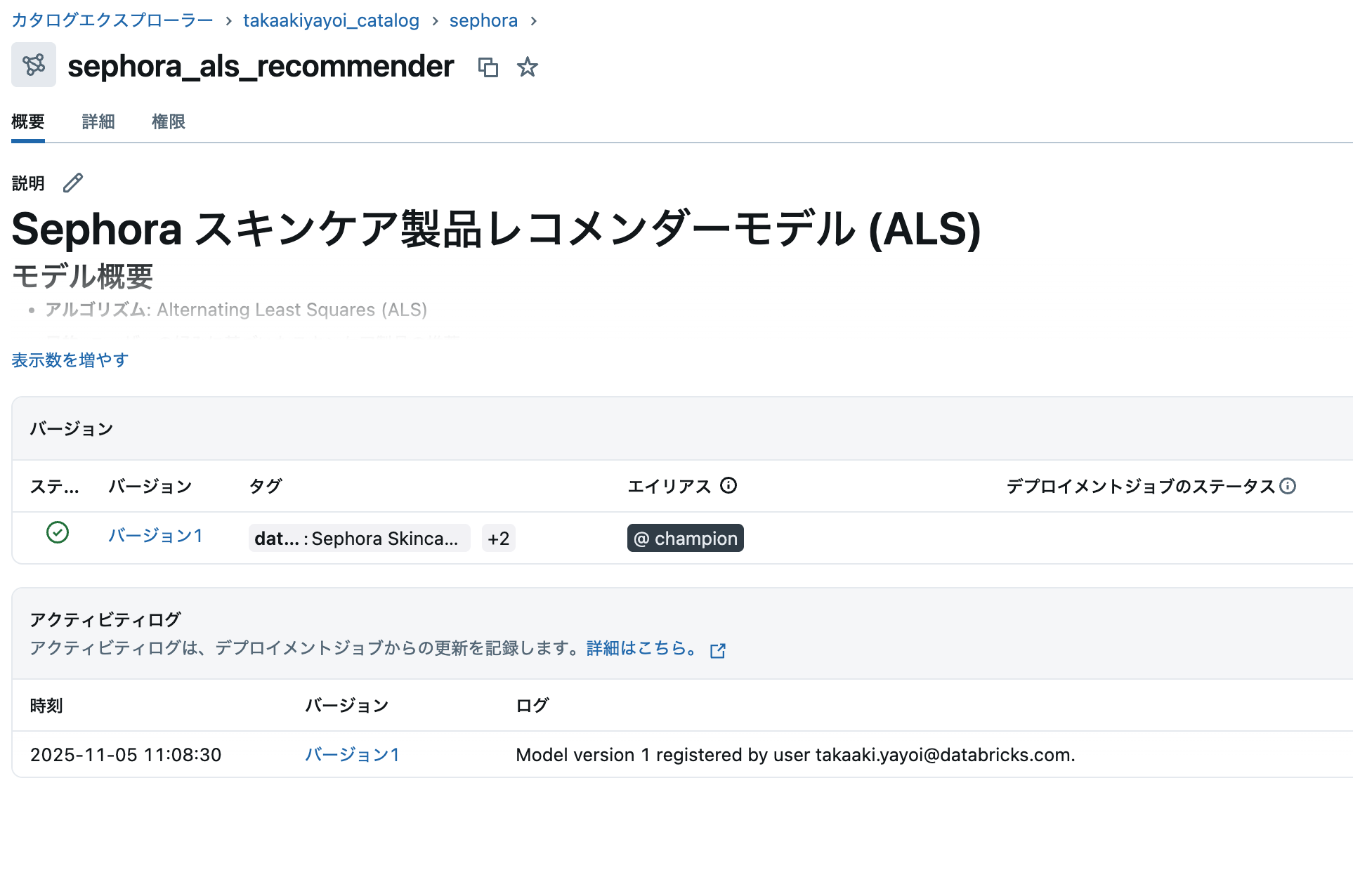
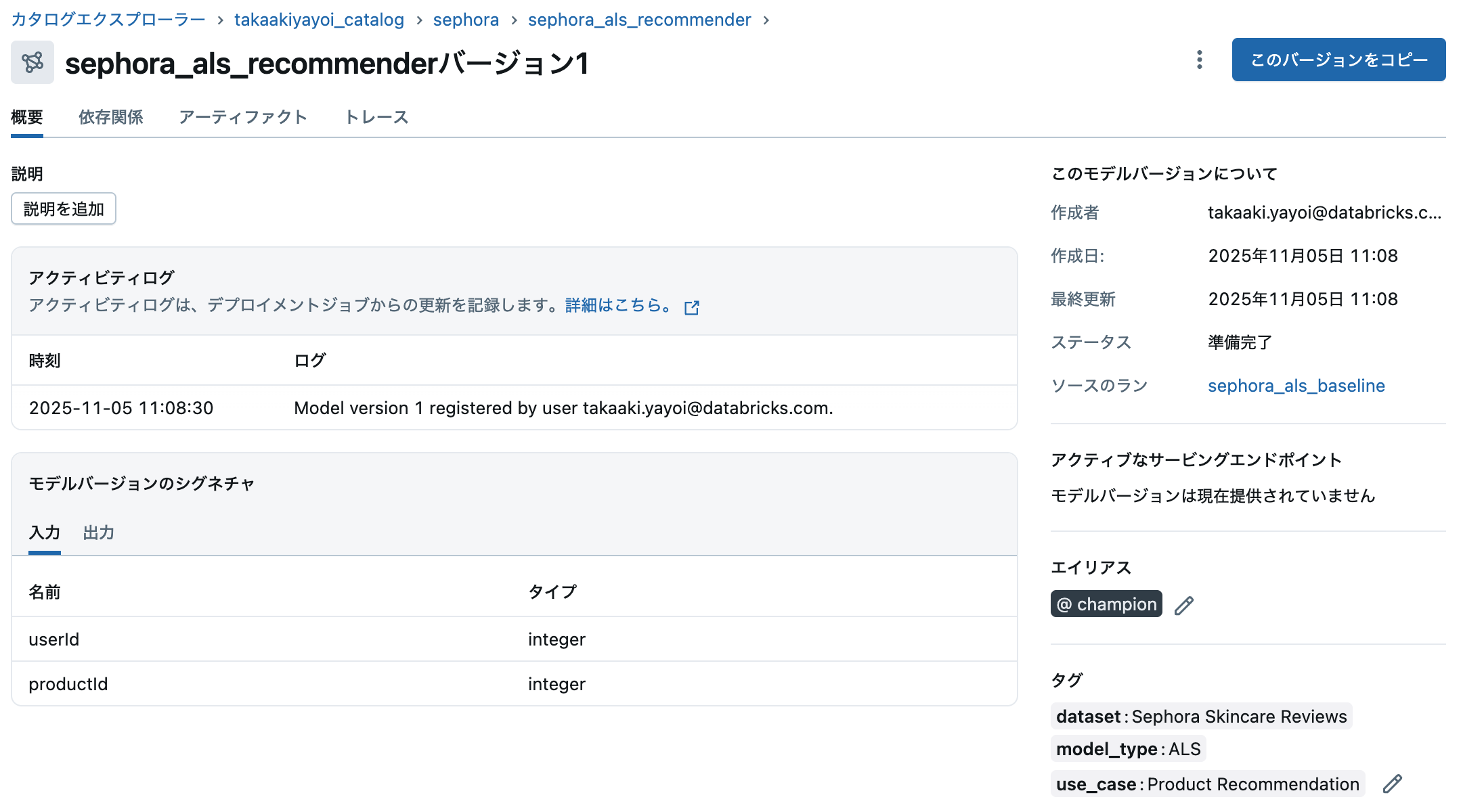
また、上のステップでリネージを設定しているので、このモデルがどのデータを用いてトレーニングされたのかを確認することができます。
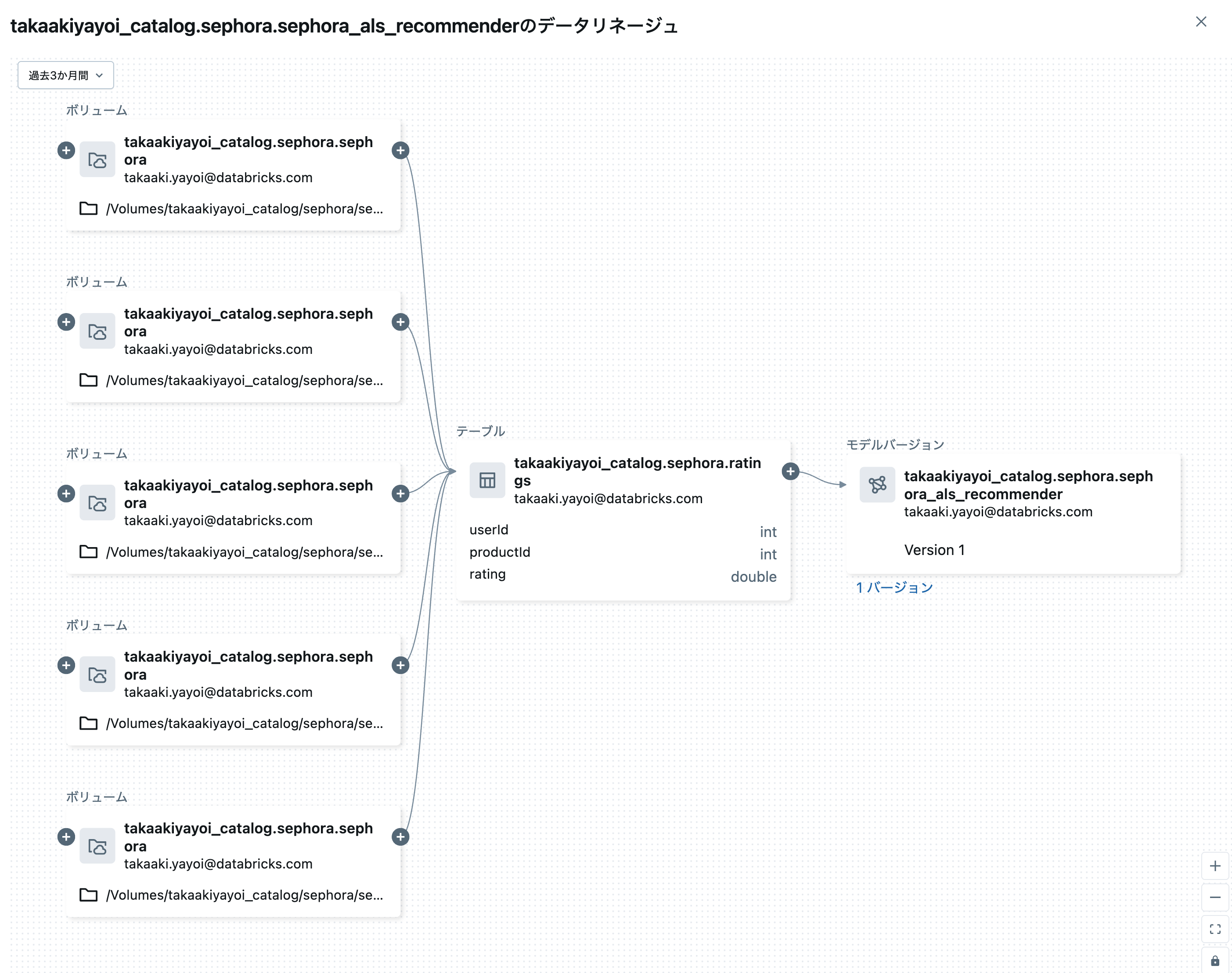
モデルのロードと使用例
# Unity Catalogからモデルをロード
loaded_model = mlflow.spark.load_model(f"models:/{UC_MODEL_NAME}@Champion")
print("✓ モデルをロードしました")
print(f" モデル名: {UC_MODEL_NAME}")
print(f" エイリアス: Champion")
# サンプルユーザーと製品のペアを作成
sample_users = training.select("userId").distinct().limit(3).collect()
sample_products = products_indexed.select("productId").limit(10).collect()
# ユーザーと製品のペアを作成
from itertools import product as itertools_product
user_product_pairs = [
(user[0], product[0])
for user, product in itertools_product(sample_users, sample_products)
]
# DataFrameに変換
from pyspark.sql.types import StructType, StructField, IntegerType
schema = StructType([
StructField("userId", IntegerType(), False),
StructField("productId", IntegerType(), False)
])
user_product_df = spark.createDataFrame(user_product_pairs, schema)
# 予測を実行
predictions_sample = loaded_model.transform(user_product_df)
print("\n=== サンプル推薦結果 ===")
display(
predictions_sample
.join(products_indexed, "productId")
.select("userId", "product_name", "brand_name", "prediction")
.withColumnRenamed("prediction", "predicted_rating")
.orderBy("userId", desc("predicted_rating"))
.limit(30)
)
✓ モデルをロードしました
モデル名: takaakiyayoi_catalog.sephora.sephora_als_recommender
エイリアス: Champion
=== サンプル推薦結果 ===
| userId | product_name | brand_name | predicted_rating |
|---|---|---|---|
| 2366 | 7 Day Face Scrub Cream Rinse-Off Formula | CLINIQUE | 2.9574928283691406 |
| 2366 | Goodbye Acne Max Complexion Correction Pads | Peter Thomas Roth | 2.82841157913208 |
| 2366 | Grape Water Moisturizing Face Mist | Caudalie | 2.513127326965332 |
| 2366 | Clarifying Lotion 1 | CLINIQUE | 2.3645267486572266 |
| 2366 | Repairwear Anti-Gravity Eye Cream | CLINIQUE | 2.22860050201416 |
| 2366 | Rinse-Off Foaming Cleanser | CLINIQUE | 1.8009891510009766 |
| 2366 | Renewing Eye Cream | Murad | 1.6064350605010986 |
| 2366 | All About Lips | CLINIQUE | 1.280785083770752 |
| 2366 | Exfoliating Face Scrub | CLINIQUE | 1.2557634115219116 |
| 2366 | All About Eyes Eye Cream | CLINIQUE | 1.2086994647979736 |
| 13285 | Repairwear Anti-Gravity Eye Cream | CLINIQUE | 5.050063133239746 |
| 13285 | Grape Water Moisturizing Face Mist | Caudalie | 4.690354347229004 |
| 13285 | Goodbye Acne Max Complexion Correction Pads | Peter Thomas Roth | 4.587014198303223 |
| 13285 | 7 Day Face Scrub Cream Rinse-Off Formula | CLINIQUE | 4.5565266609191895 |
| 13285 | Rinse-Off Foaming Cleanser | CLINIQUE | 4.130077362060547 |
| 13285 | Exfoliating Face Scrub | CLINIQUE | 4.118031024932861 |
| 13285 | All About Eyes Eye Cream | CLINIQUE | 3.820549726486206 |
| 13285 | Clarifying Lotion 1 | CLINIQUE | 3.7927842140197754 |
| 13285 | Renewing Eye Cream | Murad | 3.564669609069824 |
| 13285 | All About Lips | CLINIQUE | 3.2064852714538574 |
| 17679 | Clarifying Lotion 1 | CLINIQUE | 3.8727896213531494 |
| 17679 | All About Lips | CLINIQUE | 2.949568271636963 |
| 17679 | Grape Water Moisturizing Face Mist | Caudalie | 2.3585615158081055 |
| 17679 | Goodbye Acne Max Complexion Correction Pads | Peter Thomas Roth | 2.3345608711242676 |
| 17679 | Rinse-Off Foaming Cleanser | CLINIQUE | 2.0911519527435303 |
| 17679 | Repairwear Anti-Gravity Eye Cream | CLINIQUE | 1.923648476600647 |
| 17679 | All About Eyes Eye Cream | CLINIQUE | 1.9038817882537842 |
| 17679 | Exfoliating Face Scrub | CLINIQUE | 1.6859986782073975 |
| 17679 | Renewing Eye Cream | Murad | 1.5239790678024292 |
| 17679 | 7 Day Face Scrub Cream Rinse-Off Formula | CLINIQUE | 1.125195026397705 |
9. まとめ
このノートブックでは、以下を実施しました:
- データ準備: Unity Catalogテーブルからのデータ読み込み(110万レビュー、8,500製品)
- 探索的分析: SQL・Pythonによる製品タイプ、ブランド、価格帯の分析
- モデリング: ALSアルゴリズムを使用したスキンケア製品レコメンダーの構築
- 評価: RMSE・MAEによるモデル性能の評価と可視化
- 推薦生成: ユーザーへのトップ10製品推薦と多様性分析
- MLflow統合: 実験管理、モデルの自動記録、データリネージ
- Unity Catalogモデル登録: モデルのバージョン管理とガバナンス
作成されたアセット
-
Unity Catalogテーブル:
takaakiyayoi_catalog.sephora.* -
登録済みモデル:
takaakiyayoi_catalog.sephora.sephora_als_recommender -
MLflow Experiment:
/Users/takaaki.yayoi@databricks.com/20251104_sephora_als/sephora_recommender_experiment
次のステップ
- Databricks SQLダッシュボード: 推薦結果とビジネスメトリクスの可視化
- Genie: 自然言語でのデータ分析とインサイト抽出
- Model Serving: リアルタイム推薦APIの構築とデプロイ
- ハイパーパラメータチューニング: グリッドサーチで精度向上
- ユーザー属性活用: 肌タイプなどを考慮したハイブリッド推薦
- A/Bテスト: 推薦アルゴリズムの効果測定
